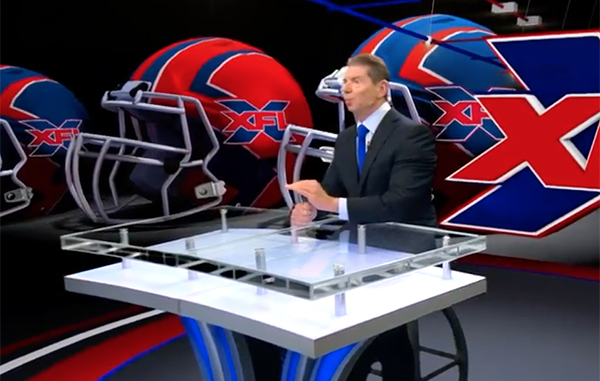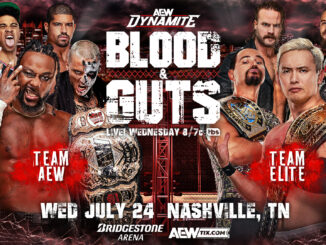
SPOTLIGHTED PODCAST ALERT (YOUR ARTICLE BEGINS A FEW INCHES DOWN)...
When the ridiculous became reality at 3 p.m. ET on Thursday afternoon with the official announcement of the XFL’s return, you had both a frenzy of excitement from the wrestling fanbase and an understandable eyeroll from the traditional sports fan. Despite all of its faults during the 2001-and-done season, the XFL is looked at lovingly by many through the rose-colored glasses of nostalgia.
The buzz that propelled the XFL to a monstrous 9.5 opening night rating in 2001 is much different than the buzz that is surrounding its comeback – and the buzz that will surround it when that fateful day arrives in 2020. In 2001, no one knew what to expect and, with wrestling being what wrestling was during that era, all bets were off. The cultural landscape is vastly different now and, much like with all media, what was acceptable in 2001 isn’t remotely close to making it on air in 2018. It was clear in Vince McMahon’s press conference that he was more than aware of that fact and the 2018 “family friendly” XFL is similar in name only to its predecessor.
In 2001, the XFL was groundbreaking in its development of the skycam. They allowed the players to actually celebrate – something in the NFL you would be penalized for. The players – and broadcasters – were all encouraged to “be outrageous” and television would exploit those personalities. In the 17 years since the XFL debut, many of the things that made it so special are now commonplace in the NFL. There is no uniqueness in a skycam; it’s a part of the game now. The NFL’s ban on celebrations has been lifted. On every broadcast – from pregame to postgame – the NFL hires every “personality” they can and, in many cases, broadcasters with far more experience in the field are rejected in favor of a Michael Irvin or Steve Smith.
So how in 2020 can this new XFL not only maintain what is sure to be an initial buzz, but also prosper for the short term and survive in the long term?
First and foremost, the TV contract will be an absolutely huge piece of the survival puzzle. While a suitor like NBC may not shell out $30 million like they did in 2001, there are far more networks now that didn’t even exist in 2001 that may be willing to roll the dice on an XFL rebirth. Make no mistake, the XFL would be completely unsubstantial on a WWE Network streaming platform aside from random pregame or postgame shows. The TV landscape is so wide and varied now that it’s impossible to guess where the XFL will land. But keep in mind that, despite its complete collapse in 2001, that XFL primetime ratings at worst were a 1.6 – which would put it in the upper half of 2017 primetime programming.
Much like in wrestling, the true key to the league’s survival will be to make stars. Any former “name” NFL talent will be a tremendous boost to the XFL initially, but in wrestling terms, any name talent will really just be there to elevate potential new talent. With the clock already ticking on aging names like Colin Kaepernick and Tim Tebow, their true value is getting eyeballs on the product. From that point on, the hopes of the XFL rests on their ability to recruit potential stars.
When the NFL’s rival league, the USFL, was formed in 1982, they actively recruited top stars out of college to forego the NFL and play for them. The XFL will need a similar approach, and the fact that the NFL actually established it’s own “Rookie Salary Cap” several years ago actually opens the door for a collegiate player to take a higher offer from an XFL team and then move on to the NFL when that deal expires (similar to what Hall of Famers Reggie White and Jim Kelly did in the 1980s). The ability to recruit players out of college (a/k/a outbid the NFL) and not just use NFL castoffs as the league did in 2001 is the primary key in making the league viable to your casual fan.
The casual fan will be the true determining factor in the XFL’s survival. They have to do everything in their power to try and tap into an emotional connection with the casual fan. Without franchises that draw on years of history and loyalties being passed on through generations of family, XFL franchises have to approach it from a different angle.
The upstart Charlotte Bobcats had the right idea in 2005, when they drafted two players off of the North Carolina National Championship team. While they didn’t come close to a winning season, they immediately tapped into the heart of the local fanbase and, by doing so, hit an (albeit temporary) economic and emotional homerun. The XFL should have individual team owners that are both passionate and who fans can resonate with. While Vince denounced the possibility of individually owned franchises at the press conference, the benefit of having an owner should not be overlooked. Take Mark Cuban for instance – the publicity, intrigue, and just pure passion for winning that he would bring to the table can’t be understated.
In the broadcast booth, the XFL needs to tap into the pulse of the sports fan – not just the wrestling fan. With the number of layoffs that ESPN has done over the past year, there will be any number of personalities who add instant credibility and don’t have the “wrestling stigma” tied to them. Reaching into the social media landscape, the XFL would be wise to tie themselves to something like Barstool Sports which has done a tremendous job marketing themselves into this irreverent online personality with its own devoted fanbase, spearheaded by former Indianapolis Colt Pat McAfee. Despite the “family-friendly” edict of the new XFL, McAfee leading – or at least providing John Madden-esque insight – for a Saturday Night XFL broadcast could be the perfect marriage the league needs.
Every year there are tremendous coaches in the NFL that get fired, but in 2001 the XFL’s head coaches had no strong NFL pedigree. The old cliché is, “You have to spend money, to make money,” but again, this is an area that the XFL will have to bite the bullet on to reach a larger audience. While a John Gruden may have truly been too rich for XFL blood, who knows if the right offer wouldn’t intrigue a Bruce Arians two years down the road. There are plenty of quality offensive and defensive coordinators in the NFL that could be lured for the right offer combined with the chance to be a head coach. After all, what’s the worst case scenario? The league folds and you go right back to the NFL. Remember, anyone that takes part in the NFL won’t be blackballed and, for a recently fired coach who maybe just had a bad year, the XFL could be the redemption needed.
Since many of the promotional tactics the XFL used in its 2001 debut can’t be used today, the XFL will do everything in it’s power to emphasize the negativities of the NFL and rectify those. The two hottest topics of the past year have been the kneeling during the national anthem and the “What is a catch?” dilemma; both of those being far trickier to capitalize on than simply allowing celebrations two decades ago. Clearly not having players on the field during the anthem – which was the case in the NFL prior to 2009 – is the simplest way to handle that. You can do a big pomp and circumstance “Rah Rah America” production, but not having the players seen (until an elaborate team entrance) eliminates that as a distraction without taking any kind of political side. If the XFL is determined to make players stand for the Anthem as alluded to in the press conference, then they are actually taking a political side no matter what the reasoning or wording is.
The “process of a catch” rule is even trickier, although the elimination of any instant replay would both speed up the game and allow for a water cool like discussion the next day on controversial plays. Remember, the XFL needs people talking about their product more than just getting a 16 yard catch called correctly. I was very relieved to hear in the press conference that they would be shooting for a two hour window for broadcast. Whether that’s done by the elimination of halftime or shorter quarters, anything close to the pacing of college basketball would help not only the games be closer contests that come down to the final drive, but also help hide the lack of quality of play as its not drawn out for 3-plus hours.
One potential revenue source that wasn’t touched on in the press conference but was mentioned in the opening sizzle reel was the possibility of a more interactive format for gambling and/or daily fantasy sports, both of which are illegal in many states. It wouldn’t be a surprise at all to see some of the larger daily fantasy leagues partner up with the XFL as a relationship there (that could include constant on-screen sponsored updates to fantasy scoring as players progress through a live game) could be extremely beneficial to both.
Personally, I want the league to survive. If done right, any football league has a chance for survival in America; both the AFL and USFL have proven that in years past. However, just the name “XFL” alone has such a strong stigma – both good or bad – depending on your perspective, it’s hard not to wonder if this vastly different XFL is already doomed just because of the comparisons. Out of sheer willpower alone, Vince will make sure the league stays afloat for two years (he was on board for the original XFL getting a second season). Anything past that point will be determined within those first two seasons by whatever good will, loyalty, and passion the #XFL2020 can cultivate.
Grant Sawyer has been the technical director for over 600 professional wrestling events and is the editor of “The History of Professional Wrestling” books at Amazon. You can follow him on Twitter @Statmark.




Leave a Reply
You must be logged in to post a comment.